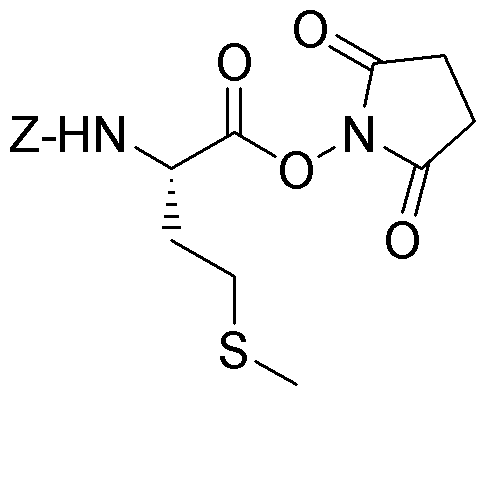Z-L-methionine N-hydroxysuccinimide ester is widely utilized in research focused on:
- Peptide Synthesis: This compound serves as a valuable building block in the synthesis of peptides, enabling researchers to create specific sequences that are crucial for drug development and biological studies.
- Bioconjugation: It is used for attaching biomolecules, such as proteins or antibodies, to other molecules, enhancing the functionality of therapeutic agents in targeted drug delivery systems.
- Protein Modification: The ester facilitates the modification of proteins, allowing scientists to study protein interactions and functions, which is essential in fields like biochemistry and molecular biology.
- Diagnostics: In the development of diagnostic tools, this compound can be employed to create labeled antibodies or other biomolecules, improving the sensitivity and specificity of tests.
- Research in Drug Development: Its role in creating novel compounds makes it a key player in pharmaceutical research, helping to identify new therapeutic candidates with enhanced efficacy.
General Information
Properties
Safety and Regulations
Applications
Z-L-methionine N-hydroxysuccinimide ester is widely utilized in research focused on:
- Peptide Synthesis: This compound serves as a valuable building block in the synthesis of peptides, enabling researchers to create specific sequences that are crucial for drug development and biological studies.
- Bioconjugation: It is used for attaching biomolecules, such as proteins or antibodies, to other molecules, enhancing the functionality of therapeutic agents in targeted drug delivery systems.
- Protein Modification: The ester facilitates the modification of proteins, allowing scientists to study protein interactions and functions, which is essential in fields like biochemistry and molecular biology.
- Diagnostics: In the development of diagnostic tools, this compound can be employed to create labeled antibodies or other biomolecules, improving the sensitivity and specificity of tests.
- Research in Drug Development: Its role in creating novel compounds makes it a key player in pharmaceutical research, helping to identify new therapeutic candidates with enhanced efficacy.
Documents
Safety Data Sheets (SDS)
The SDS provides comprehensive safety information on handling, storage, and disposal of the product.
Product Specification (PS)
The PS provides a comprehensive breakdown of the product’s properties, including chemical composition, physical state, purity, and storage requirements. It also details acceptable quality ranges and the product's intended applications.
Certificates of Analysis (COA)
Search for Certificates of Analysis (COA) by entering the products Lot Number. Lot and Batch Numbers can be found on a product’s label following the words ‘Lot’ or ‘Batch’.
Numéro de catalogue
Numéro de lot/série
Certificates Of Origin (COO)
This COO confirms the country where the product was manufactured, and also details the materials and components used in it and whether it is derived from natural, synthetic, or other specific sources. This certificate may be required for customs, trade, and regulatory compliance.
Numéro de catalogue
Numéro de lot/série
Safety Data Sheets (SDS)
The SDS provides comprehensive safety information on handling, storage, and disposal of the product.
DownloadProduct Specification (PS)
The PS provides a comprehensive breakdown of the product’s properties, including chemical composition, physical state, purity, and storage requirements. It also details acceptable quality ranges and the product's intended applications.
DownloadCertificates of Analysis (COA)
Search for Certificates of Analysis (COA) by entering the products Lot Number. Lot and Batch Numbers can be found on a product’s label following the words ‘Lot’ or ‘Batch’.
Numéro de catalogue
Numéro de lot/série
Certificates Of Origin (COO)
This COO confirms the country where the product was manufactured, and also details the materials and components used in it and whether it is derived from natural, synthetic, or other specific sources. This certificate may be required for customs, trade, and regulatory compliance.


